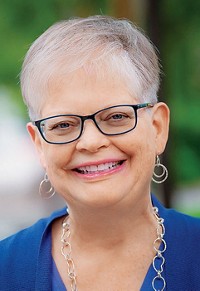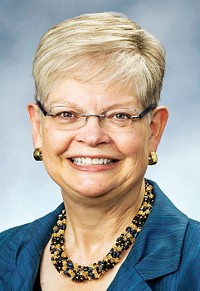Advertisement
Grab your lab coat. Let's get started
Welcome!
Welcome!
Create an account below to get 6 C&EN articles per month, receive newsletters and more - all free.
It seems this is your first time logging in online. Please enter the following information to continue.
As an ACS member you automatically get access to this site. All we need is few more details to create your reading experience.
Not you? Sign in with a different account.
Not you? Sign in with a different account.
ERROR 1
ERROR 1
ERROR 2
ERROR 2
ERROR 2
ERROR 2
ERROR 2
Password and Confirm password must match.
If you have an ACS member number, please enter it here so we can link this account to your membership. (optional)
ERROR 2
ACS values your privacy. By submitting your information, you are gaining access to C&EN and subscribing to our weekly newsletter. We use the information you provide to make your reading experience better, and we will never sell your data to third party members.
Careers
A Chemist In Charge
Marye Anne Fox, chancellor of UC San Diego, reflects on the challenges of leading a top-tier research university
September 17, 2007
| A version of this story appeared in
Volume 85, Issue 38
BY ANY RECKONING, Marye Anne Fox, chancellor and professor of chemistry at the University of California, San Diego, is one of the most influential women in science and academia today. UC San Diego ranks as one of the top 10 research universities in the country, and Fox—a familiar face in science policy circles—is a member of President George W. Bush's Council of Advisors on Science & Technology (PCAST). Among many other appointments, she now serves on the National Academy of Sciences' (NAS) Committee on Science, Engineering & Public Policy and as a cochair of its Government-University-Industry Research Roundtable. She previously served on the academy's council and on its governing board.
Before being named chancellor of UC San Diego, Fox served as chancellor and distinguished university professor of chemistry at North Carolina State University and as M. June & J. Virgil Waggoner Regents Chair in Chemistry and vice president for research at the University of Texas, Austin. Fox received a bachelor's degree in chemistry from Notre Dame College, South Euclid, Ohio, and a Ph.D. in chemistry from Dartmouth College. After a postdoctoral appointment at the University of Maryland, College Park, she joined the faculty of UT Austin in 1976.
Fox maintains an active research program at UC San Diego with her husband, chemistry professor James K. Whitesell. She is a physical organic chemist who has published more than 350 refereed papers, six books, and nearly 30 book chapters, mostly in organic photochemistry and electrochemistry. More than 50 advanced degrees have been awarded under her supervision.
Fox has a long history of service to science and scholarship. She is a member of the American Chemical Society, NAS, and the American Philosophical Society. She is also a fellow of the American Academy of Arts & Sciences and the American Association for the Advancement of Science. ACS has honored her with its Charles Lathrop Parsons Award and the Francis P. Garvan-John M. Olin Medal, and she has been named an Arthur C. Cope Scholar. She has been an Alfred P. Sloan Fellow and a Camille & Henry Dreyfus Teacher-Scholar and is the recipient of six honorary degrees. Recently, she sat down for an interview with C&EN News Editor William G. Schulz for a wide-ranging interview about her career and the challenges she faces at UC San Diego.
You have been chancellor of UC San Diego since 2004. What's your favorite part of the job?
My favorite task is interacting with our students and being able to think about ways to build infrastructure and opportunities for them.
Is the title "chancellor" the same as "president" at another university?
At UC San Diego, the title "chancellor" designates the chief campus officer. In that role, I am responsible for all aspects of UC San Diego, not the other nine campuses in the UC system.
What are you doing to maintain UC San Diego's ranking as one of the top 10 research universities?
I try to assemble the best groups of students and faculty—then stand back so they can do what they do best. The faculty here is more collaborative and cooperative than any place I have ever been. It's really very striking. Our faculty members naturally work together. My role is to help them achieve the objectives they set for themselves by investing in what they need. Most planning on this campus is done by the faculty, not the administration. Once you have a strong relationship with the academic senate, professors will present really marvelous intellectual opportunities. The chancellor's role is to support their efforts.
What are some of the most pressing challenges for top-ranked research universities?
The first challenge is most obvious: securing money to invest in the best faculty and state-of-the-art technology and facilities. At all universities, tuition and fees have increased dramatically in the last several years. For public universities, these increases largely offset cuts in state funding. So our challenge is to ensure accessibility and affordability of a college education for students thinking about coming to a first-class university. Financial aid can help students with the greatest financial need, and those from wealthy families can handle the costs. But we worry a great deal about middle-class students and their access to a public institution like UC San Diego.
We work hard to make sure that the academic requirements for admission are obvious because UC San Diego is a very selective institution. We admit about 4,000 freshmen, and last year we had about 45,000 applications for those slots. Once we admit any student, we work very hard to assemble the best possible financial aid package of state and/or federal grants, as well as subsidized loans. Students graduate with debt, but with a burden that, because of the top-quality preparation they get here, they are prepared to assume.
What about the impact on research of state budget cuts?
The reality is that state budget increases have typically been subinflationary. So faculty salaries at most public institutions have regressed in relative ranking against private peers throughout the U.S. That's of great concern. Our strong faculty members get multiple offers. We must assemble strong recruiting—or retention—packages to attract and retain the best faculty.
The business model for public universities has changed. It used to be that a faculty member would start as an assistant professor at a low salary level, which would build up as a professor until retirement age. The difference between the relatively high salary for a full professor and an incoming salary for an assistant professor would be used to provide equipment and to cover other start-up costs for the assistant professor.
What happens now is that the salary for an assistant professor is close to the full professor's salary. In some cases, for business faculty, for example, an even higher salary is required for an assistant professor. In an era of declining state resources for higher education, you find that when you couple inversion of salaries with the size of the recruiting packages, which are substantial, we are very near the maximum that can realistically be supported by fees or tuition.
Where will that investment come from? In a research university like UC San Diego, some will come from competitive grants at the federal or state level. Some will come from local private sources. Of course, a lot will come from philanthropy. The chancellor has to make sure that all of those revenue sources are optimized and funds are being used effectively to provide the best quality of education for our students.
What's your take on federal research funding today?
It's a real challenge. UC San Diego is an institution that receives a major portion of its funding from the National Science Foundation and the National Institutes of Health. NIH funding is flat, at best. So far, our very strong faculty have been able to successfully compete for the support that's available. As a result, we haven't suffered as seriously as some of our peers. But we're very cautious. The direct costs of research are important, as are the indirect costs of maintaining facilities that allow that research to be conducted safely and efficiently.
What about the rise of corporate funding of research? Have you had to reach out more to the corporate community?
We have very strong corporate relationships here. San Diego is one of the premier biotechnology centers in the U.S. More than 200 companies work in collaboration with UC San Diego, either through our faculty or through intellectual property (IP) generated here. Despite these strong relationships, industrial collaboration accounts for less than 10% of our research budget. That is, we rely even more significantly on competitive peer-reviewed grants and contracts from the federal and state government.
Nonetheless, are you concerned about the rise of corporate funding and the impact on the independence of research?
We've got terrific people at UC San Diego who oversee our efforts to monitor potential conflicts of interest. They work in-depth on each case whenever a question arises. It's possible in almost every case to find a way for the campus to manage the conflict and to exercise its ethical responsibility to make sure that the finances and the conduct of research are fully in accord with the highest ethical standards.
I am very pleased with the internal control that we have taken so very seriously. Some faculty members may disagree with some of the decisions reached by the conflict-of-interest committee, but by and large, the committee and faculty can reach agreement. They do a superb job.
Do you see patenting as a means of income for the university, a means of technology transfer, or both?
Patenting brings university faculty and our collaborators to the table, and patenting is necessary if you want to start a company. License income is becoming a significant factor. So far, the university hasn't made too much money, although we run essentially in the black. Our technology-transfer operation is substantial because our IP is important to biotech partners, as well as those related to wireless technologies and communications. Our very strong connections to the community demand success in licensing agreements.
Can you give an example of one of the successes?
Our best example is the formation of Qualcomm [in 1985]. That was done while Irwin M. Jacobs was a UC San Diego faculty member. He left the university to work as a consultant but then started his own company. He has been one of our most generous benefactors.
But there are also many other small companies that you may not hear as much about that are based on UC San Diego IP. Many are in the biotech field and rely on IP generated at UC San Diego.
How can we encourage more U.S. students to pursue careers in science, math, and engineering?
We have an active outreach program to K-12 schools in San Diego. We also operate a charter school on our campus—the Preuss School—which has recently been ranked as the ninth best high school in the U.S. The Preuss School admits students who meet three criteria: They qualify for school lunch assistance, neither parent is a college graduate, and the parents must be willing to devote time to the success of the institution. These criteria do not emphasize grades, class rankings, or standardized test scores. Those kids who are eligible constitute a pool from which admitted students are chosen by lottery.
At the Preuss School, the expectation is that each graduate should go to college. And they do-greater than 95% every year, almost all to four-year colleges. Some of the Preuss graduates, I am proud to say, come to UC San Diego. In fact, the president of our student body is a graduate of the Preuss School.
UC San Diego has a very high enrollment of women, but in the U.S. in general, this hasn't translated into women in academic careers in science and engineering. What is missing?
We are indeed very proud that so many women are interested in science and engineering here. But you correctly capture the challenge we face in recruiting women to academic positions, whether it's faculty or administration. I can't tell you why that is. I can tell you we work very hard to make sure there is gender equity in candidate pools and that the evaluation of work from men and women is fair and equitable.
Do you maintain an active research program?
I have an active research grant from the Department of Energy that supports two postdoctoral fellows. I don't have time every day to be in the laboratory, but I collaborate with my husband, Jim Whitesell, who is a coprincipal investigator on that grant. Because he is in the chemistry department, he can provide day-to-day interaction with the postdocs. We get together frequently to discuss general directions, to write papers, and to think critically about the research results—an ideal situation for me that can be accommodated with my schedule. It does keep me excited, and I don't think I'd ever be able to completely give up research in chemistry.

What particular issues have you looked at as a member of PCAST?
I led one study on broadband infrastructure, and I have worked on studies on the American scientific workforce, on terrorism, on personalized medicine, and on nanotechnology. President Bush has asked us to look at quite an interesting range of topics.
Advertisement
What issues in science and technology policy most interest you today?
The workforce issue—getting the next generation of bright young men and women to think about scientific careers—is one of my passions. Well-educated students will be the next-generation leaders in a global society. Therefore, I encourage students to take foreign languages because I believe it's going to be vital.
In my own family, my oldest son got his first job in Austin, Texas. He was soon transferred to Grenoble, France, and he is now in Singapore. Increasingly, we're going to see that as the course educated people will take: living abroad to learn a different culture and to sharpen scientific expertise. This career path enhances understanding of cultural dynamics that influence success.
One of the most exciting things about U.S. higher education is that students really do have the option to go global. I think it's very important that we offer study- abroad opportunities to our students so that they may make wise decisions about future career options.
What other challenges do you see on the horizon?
Funding. Identifying the necessary funding in an era of declining state support to enhance higher education and support the research that is vital to the country's future. At UC San Diego, a state institution, only 12% of our budget last year came from the State of California. The remainder came from philanthropy or research grants or fees. So it is a challenging time financially.
Despite those challenges, it's an exciting time to employ science to address problems that confront society. We at UC San Diego are very pleased to be able to host some of those emerging activities. For example, [genomics pioneer] Craig Venter is building a facility on our campus. The institute will look at marine metagenomics, analyzing microbes using the resources of what is called an institute for science and innovation. Together, our California Institute for Telecommunications & Information Technology and Venter will use their separate resources to improve research capabilities.
We also have formed a major stem cell consortium with other local research institutes as a consequence of a ballot initiative in November 2004. We have a new emphasis on global health and a very strong emphasis on environment because of the Scripps Institution of Oceanography. We also have a brand-new Institute on Environmental Sustainability that takes advantage of that basic research contribution.
How has your training in chemistry helped you in your career in university administration?
I have long argued that chemistry provides great training because of its place at the center of science. Plus, it is a good balance of the quantitative and the practical. It has served me very well. I have a wonderful career, and I am blessed to hold an appointment at a place like UC San Diego.
When did you first become interested in science, and who encouraged you?
It will tell you a lot about my age if I tell you I was inspired by Sputnik, which is celebrating its 50th anniversary soon. But I did go through elementary and junior high school during the Sputnik years. It was a given in that period that anyone who was reasonably smart would at least consider a career in science and engineering. I would be delighted if something would engender that same kind of fervor in the next class of students, male and female.
What do you like to do on your time off?
I am an avid, if mediocre, golfer. This is a good place to golf: You can go to public or private courses that are within minutes of the campus. I read a lot. And apart from that, there isn't very much time. I used to say that I raise children, but my children are all adults, and I am on to grandchildren. Unfortunately, three of them are in Singapore and all the rest of them are in Texas, so I don't see them as often as I would like.







Join the conversation
Contact the reporter
Submit a Letter to the Editor for publication
Engage with us on Twitter